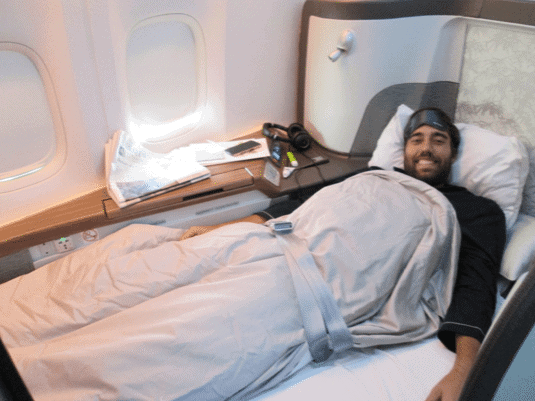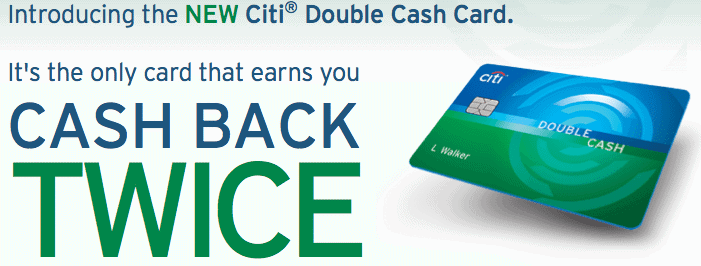MileValue is part of an affiliate sales network and receives compensation for sending traffic to partner sites, such as CreditCards.com. This compensation may impact how and where links appear on this site. This site does not include all financial companies or all available financial offers. Terms apply to American Express benefits and offers. Enrollment may be required for select American Express benefits and offers. Visit americanexpress.com to learn more.
Note: Some of the offers mentioned below may have changed or are no longer be available. You can view current offers here. All values of Membership Rewards are assigned based on the assumption, experience and opinions of the MileValue team and represent an estimate and not an actual value of points. Estimated value is not a fixed value and may not be the typical value enjoyed by card members.
Citi has just released a new cash back card that is the best on the market:
Citi® Double Cash Card – 18 month BT offer
You earn 1% back when you make a purchase and another 1% back as you make payments. You should, of course, pay in full every month to avoid interest. This has the added benefit of getting your cash back more quickly.
The 1% + 1% cash back and no annual fee immediately make the Citi® Double Cash Card – 18 month BT offer the best cash back card on the market.
This card is slightly better than the Fidelity Investment Rewards American Express, which offers 2% back and no annual fee, for three reasons:
- The Citi Double Cash is a MasterCard, and the Fidelity card is an American Express. MasterCards are more widely accepted.
- The Citi Double Cash’s rewards can be redeemed in increments of $25 for statement credits. You have to wait until you have $50 in rewards on the Fidelity card.
- The Fidelity card requires you to have a Fidelity account. That’s one more step.
The Citi® Double Cash Card – 18 month BT offer also clearly has a chip in its promotional images. I don’t see whether it’s chip and PIN (more useful) or chip and signature, so I’ll hold off on calling this a benefit.
- How does the Citi Double Cash Card compare to the Arrival Plus and miles earning cards?
- Who should not get the Citi Double Cash Card?
Cash Back vs. Arrival Plus vs. Miles
Many miles and points cards have category bonuses that allow you to earn 2, 3, or 5 points per dollar. Those are clearly superior to the base earning rates on the Citi® Double Cash Card – 18 month BT offer and Barclaycard Arrival PlusTM World Elite MasterCard®. But let’s look at non-bonused spending.
vs. Arrival Plus
The Barclaycard Arrival PlusTM World Elite MasterCard® earns 2 miles per dollar on all purchases, which is worth 2.15% back toward travel. In May, Barclaycard expanded the definition of travel, so that you have a ton of options to redeem Arrival miles for statement credits.
I think most readers of this blog spend more than 2.15% of our budget on things defined as travel by Barclaycard, so to me the 2.15% is just like cash. The only reason this card isn’t hands down better than the Citi® Double Cash Card – 18 month BT offer is that it has an $89 annual fee after the first year, and the Double Cash Card never has an annual fee. You’d have to put almost $60,000 in spending on the Arrival Plus before the extra 0.15% added up to $89.
vs. miles/points earning cards
Generally I prefer miles over cash back because I can do some awesome things with miles that are exorbitantly expensive with cash like fly first class and add in stopovers and open jaws.

However if I use a miles-earning card and earn 1 mile per dollar, I am giving up earning 2% or 2.28% back. That’s like buying a mile for 2 or 2.15 cents. That’s a terrible deal.
If my options were to use a miles-earning card or the Citi® Double Cash Card – 18 month BT offer for a non-bonused purchase, I would take 1% + 1% cash back over 1 mile per dollar all day. I try not to earn 1 mile per dollar, though, by having cards with an array of category bonuses and putting a lot of my spending toward big sign up bonuses.
Who Should Not Get the Double Cash Card
Don’t get the Citi® Double Cash Card – 18 month BT offer if you want to fly international first class. Those tickets are routinely $10,000+, so you’d need a ton of cash back to get you into a flying bed.
The way to get into international first class is with airline miles. Even at 1 mile per dollar, you’ll get into international first class much faster than with 1% + 1% cash back. Some of the world’s nicest products like Singapore Suites and Cathay Pacific First Class can be had for 58,000 to 70,000 airline miles one way.
You probably wouldn’t get a cash back card to get into first class, but you’d be saddened to learn how many people come to my Award Booking Service with cash-like points that are worth a fixed value toward any flight and want to fly first class. That doesn’t work. You want airline miles or points that transfer to airline miles.
Bottom Line
The Citi® Double Cash Card – 18 month BT offer is the best cash back card on the market. It is slightly better than the previous best, Fidelity card.
It’s a legitimate option for non-bonused purchases instead of cards that earn airline miles or Arrival miles. I’m not going to get the card for now because I have the Barclaycard Arrival PlusTM World Elite MasterCard® already.
Application Link: Citi® Double Cash Card – 18 month BT offer



One point I’d like to make, you don’t have tp spend $32K on the Arrivals + card to even it out against a no annual fee card. Interestinly enough, Barclay’s views the AF itself on the Arrivals + card as a travel expense! So, you could just generate $4500 in spend, use the resulting 9K in points to wipe out the annual fee, and be back to even against a 2% cash back card. Or, if you don’t want to do that, just call Barclay’s and get a statement credit to offset the AF. I’ve done that for the US Airways Card they issue. Just my 2 cents….
If you can get the annual fee waived on the Arrival Plus, it is better than this card in my opinion. Whether you can redeem to offset the annual fee is irrelevant though because that’s just using $89 worth of points to save $89, which you can always do.
You missed the point John though I agree the best thing to do is ask them to waive the fee. The Arrival Card is worth the annual fee if you spend $32k per year. If you redeemed all 64k points (ad infinitum) the resulting points from the 10% redemption bonus would be worth $89. (or 8,900 points) The .28 extra points that the arrival card earns because of this bonus is what he’s referencing.
Barclay’s Priceline Rewards Visa. 2% back, like the travel version but without the travel requirement (or the 10% bonus)
The Priceline card that I know earns 1 point per dollar worth 1% back. Can you send me a link to the 2% version.
Hmm.. The sign up link is 1%. I’ve had my card for a couple of years now.. I guess they changed it. Never mind…
Is this card now a possibility for a downgrade play once one of my annual fee Citi cards comes due?
OK, couldn’t wait, so I called. It’s not available for conversions yet (the rep said she’d already received a number of calls about doing this). No timeline for when it might become available
“The Citi® Double Cash Card is the best cash back card on the market.” This seems overly generic; it’s only true for spending under a certain level, right? I have the Barclaycard Arrival Plus as well, but as you said in the article, as long as your spending exceeds ~$31,785 annually, the Arrival Plus is still the better card. (Unfortunately, not as markedly better as it was a month ago, which makes me a sad panda. Need to figure out how to convince them to give me a statement credit to offset that annual fee when it comes due… :-P) Anyway, just seems like that is an important qualifier, this card is still inferior to the Arrival Plus above a certain spending level.
One thing you fail to mention is the benefits that the Arrival card gives for $89. First it has no FTF, which could make up for the $89 on one trip. Second, it is a world elite mastercard, which gives you access to another range(though not much higher) of benefits. You also get access to barclay’s shopping portal, which can have some solid value for some merchants over ultimate rewards, and you get tripit pro, which is(debatably, assuming value and use it) worth $49 per year